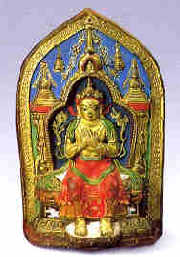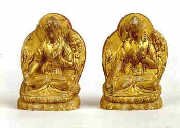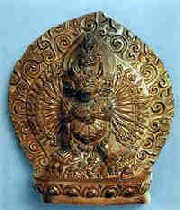 Since all the tshatshas are molded, they are not too large in size, hence their name "little statues of Buddha". By far, the largest one of those excavated measures no more than an inch in both width and height and the smallest one is no larger than a thumbnail. In most cases, they are about 9 centimeters in width and 7 in height. Though small, tshatsha serves the same purposes as other Buddhist forms, such as the mural painting andthangka. Buddhists recognize them as symbols of Buddhist merits, and use them to express their adoration and reverence for the Buddha, and their explanation of and devotion to the Buddhist doctrines, as well as their aspiration for riches and honor.
Since all the tshatshas are molded, they are not too large in size, hence their name "little statues of Buddha". By far, the largest one of those excavated measures no more than an inch in both width and height and the smallest one is no larger than a thumbnail. In most cases, they are about 9 centimeters in width and 7 in height. Though small, tshatsha serves the same purposes as other Buddhist forms, such as the mural painting andthangka. Buddhists recognize them as symbols of Buddhist merits, and use them to express their adoration and reverence for the Buddha, and their explanation of and devotion to the Buddhist doctrines, as well as their aspiration for riches and honor.
The tshatshas are colored with traditional Tibetan pigment, which is in fact a kind of mineral paint traditionally made by mixing different amounts of minerals so that they still retain their bright original colors after hundreds of years.
 Though made with the same techniques, tshatshas vary greatly from place toplace. Tshatshas found in the stupas in Jiama County, dating back to over 600 years ago in theYuan Dynasty(1271-1368 AD), feature three-dimensional patterns in high relief; details like figures and background decorations are also emphasized. The most distinctive aspect of these tshatshas is their large size, as most of them are 10 cm high and 8 cm wide, with the largest reaching as much as 26 cm in height and 20 cm in width. These tshatshas are believed to be of great value for the research on the TibetanBuddhist artin the Yuan Dynasty.
Though made with the same techniques, tshatshas vary greatly from place toplace. Tshatshas found in the stupas in Jiama County, dating back to over 600 years ago in theYuan Dynasty(1271-1368 AD), feature three-dimensional patterns in high relief; details like figures and background decorations are also emphasized. The most distinctive aspect of these tshatshas is their large size, as most of them are 10 cm high and 8 cm wide, with the largest reaching as much as 26 cm in height and 20 cm in width. These tshatshas are believed to be of great value for the research on the TibetanBuddhist artin the Yuan Dynasty.
Compared with tshatshas found in other places, those found inXialu Templeare said to be unique and worthy of collection, as they have the largest variety in terms of the ages, the patterns and the styles as well as the colors.
 Tshatshas also abound in SajiaTemple, and are famed for their delicacy and exquisiteness. Most of them are burned into colors such as red, gray or black. There are also tshatshas with two colors, an uncommon feature.
Tshatshas also abound in SajiaTemple, and are famed for their delicacy and exquisiteness. Most of them are burned into colors such as red, gray or black. There are also tshatshas with two colors, an uncommon feature.
In the Northern Sajia Temple, tshatshas with typical Indian or Nepalese artistic features can be found, which were put in the stupas when the temple was built nearly a thousand years ago. Therefore, they are referred to as having matchless artistic and historical value.
Due to its long history and unique artistic charm as well as the mysterious cultural implications, tshatsha has grown into a special category, arousing the interests of numerous experts, artists and collectors. Over the years, tshatshas, with its rich implications, various design patterns, long history and different artistic styles have become a treasured collectible item.
Author: Jessie